
Book Excerpt: How To Hook, Land Trout On Fly Gear
The following appears in the November issue of Alaska Sporting Journal:
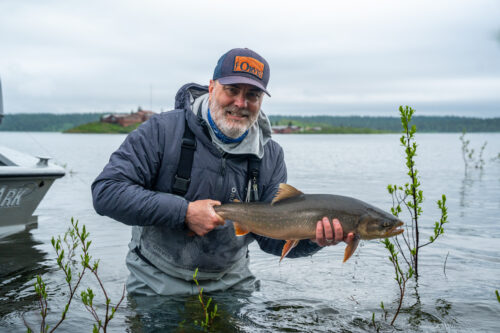
Phil Monahan’s love for fly fishing was born in New England when he was a graduate student at the University of New Hampshire. But he really found his niche when he spent multiple memorable summers guiding in Montana and Alaska (see our interview with Monahan below), where he fell in love with the trout swimming in Bristol Bay rivers and helped visiting anglers land their fish of a lifetime on fly gear.
“I learned an incredible amount from my fellow guides and clients and by simply being on the water every day for three months in a row,” Monahan writes in a new how-to book for beginning fly anglers, in collaboration with iconic outdoors brand Orvis. “This was my fly fishing university, and I made the most of it.”
Monahan also worked as an editor and writer for outdoors media outlets like American Angler, allowing him to chase his fly obsession on waters around the globe. Now he hopes his new book can give others the same obsession he developed.
“My goal for the book is that it helps people make that first step into fly fishing and find enough success to keep going,” Monahan says. “My life has been so enriched by the sport that I want others to feel some of that magic.”
In an excerpt from the book, Monahan offers a tutorial on how to set the hook and land those trophy trout you tempt with a fly. The following is excerpted from The Orvis Quick-Start Guide To Fly Fishing, by Philip Monahan and published by Lyons Press.

BY PHILIP MONAHAN
If you’ve chosen the right fly, made a good cast and presented the fly well, then that moment every fly fisher loves may occur: a fish eats your fly. Especially when you’re using dry flies, the “eat” is thrilling, as you suddenly feel connected to the quarry you’ve been seeking. But it’s not the end of the story.
If you want that fish to stay connected, you have to set the hook. It’s surprising how often a fish takes that hook point in its mouth but doesn’t get hooked, so you’ve got to do whatever you can to ensure that the pointy part is buried in the fish’s jaw. Next, you’ve got to play the fish in such a way that you bring it in as quickly as you can, keeping it away from obstacles such as submerged trees and downstream rapids, but without applying so much pressure that the tippet breaks or you pull the fly out. Finally, you’ve got to get this fighting, twisting, slippery thing in the net. Only then can you take a moment to admire the fish and celebrate your accomplishment.
HOW TO SET THE HOOK
Two common mistakes that novice fly fishers make are that they fail to set the hook at all or they set the hook too hard, breaking the fish off. As we discussed earlier, a fish can eat a fly and spit it back out very quickly, so it’s important that you are paying attention and can react quickly. (As with almost everything in fly fishing, there are a couple exceptions to this rule, which we will discuss below.) Oftentimes the fish will hook itself, so all you have to do is come tight by picking up any slack on the water, but it’s best to tilt the odds in your favor by making a good hook set.
STANDARD HOOK SET
The basic hook set involves nothing more than quickly raising your rod tip to the sky and stripping in any slack between you and the fish. Fly hooks are sharp and the mouth of a trout isn’t particularly hard, so you don’t need to drive the hook home. Simply coming tight to the trout is almost always enough to seat the hook point. If you rear back and yank on
the line, as if you were setting the hook on a largemouth bass eating a rubber worm, you stand a pretty good chance of popping the tippet, especially if you’re fishing anything lighter than 3X.
This hook-set technique works best with dry flies and nymphs, when you don’t have a lot of slack in the line. As soon as you see the trout eat the fly off the surface or the strike indicator go under, get that rod tip high and strip until you’re tight to the fish. Now you can begin to play the fish in order to get it in the net.
The one caveat here is that the standard hook set works best when the fish is upstream or across-stream from you. Hooking a fish downstream of you is more difficult because of the angle: the hook-setting motion pulls the fly directly away from the fish’s mouth. In some cases, you must wait an extra beat before setting the hook. After the fish takes the fly, it will turn to head back to the stream bottom. If you set while the fish is turning, you’re more likely to bury the hook in the side or corner of the trout’s mouth.
The standard hook set also applies to when you are swinging wet flies or streamers. Because there is already tension on the line as the fly swings through the current, trout will usually hook themselves. All you have to do is raise the rod tip, and the fight is on.
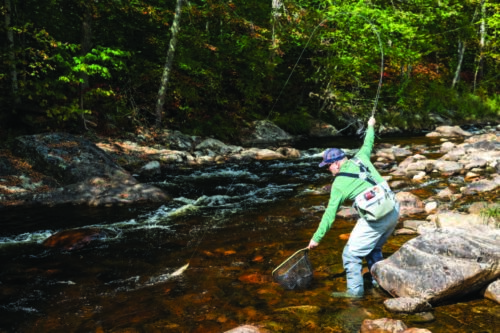
STRIP SET
Whenever you are stripping flies – whether it’s a streamer or a bass bug – you’ll want to use a strip set to set the hook. When you feel or see a fish strike, instead of raising your rod tip, keep the tip low as you use your line hand to strip quickly until you are tight to the fish. By keeping your tip low, you get a straight pull on the fly, which is most effective. Again, beware of striking too hard; although you won’t usually be using a light tippet, you do run the risk of yanking the fly out of the fish’s mouth.
If you’re accustomed to fishing dry flies and nymphs, you may be programmed to raise the rod tip whenever you get a strike. This will definitely lower your hooking rate, so it pays to prepare yourself to make a strip set instead. Train yourself to keep the rod low, and use the line, rather than the rod, to set the hook.
SWEEP SET
Two situations that make the hook set more difficult to hook fish are if the fish is downstream of you or if you have a lot of slack on the water. In these cases, you’ll want to employ a sweep set, which takes advantage of the water tension on the line to set the hook.
As described above, the standard hook set may pull the fly away from a fish that’s downstream. Instead, set the hook by sweeping your rod rearward, low and parallel to the water, and making a quick strip. Sweep the rod to your downstream side to avoid dragging the line across your body, where it could get caught on something. This will also increase the likelihood of achieving a better angle for the hook set. Once the fish is hooked, you can raise the tip.
In some cases, you need some slack on the water to achieve a good drift, but that same slack makes it more difficult to get tight to the fish. When a fish eats, the rod-tip-to-the-sky setting motion may do nothing more than pick up the slack nearest you. A sweep set removes the slack from the line and uses the tension of the line still on the water to drive the hook home. Again, sweep the rod to your downstream side, and once the fish is hooked, you can raise the tip and start stripping like a madman to remain connected to the trout.
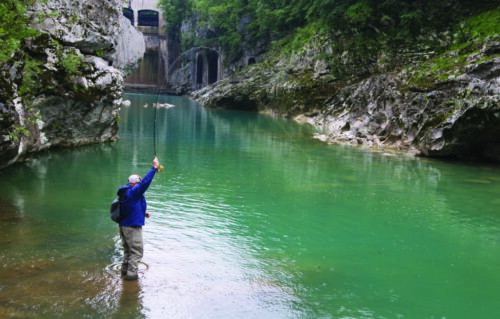
PLAYING FISH
Once you’re tight to the fish, your main goal should be to get the trout to the net as quickly as possible without pulling so hard or clamping down on the line so much that you break the tippet. Obviously, this becomes more difficult with bigger fish, heavier current, and lighter tippet.
GIVING AND TAKING LINE
Although it is important that you don’t allow any slack between you and the fish, you must be ready to give some line. The most common mistake new anglers make is that they simply squeeze the fly line against the cork handle so hard that they don’t allow the fish to take any line at all. A large fish or one that uses the current to its advantage can easily break a light tippet or a poorly tied knot. You must let a fish take some line when it runs, surges or dives toward the bottom. While keeping pressure on the line, allow it to slide outward under your finger until the fish stops again.
If you suspect that you have a big fish, you can try to “get it on the reel,” – that is, you can allow the reel’s drag system to apply the appropriate amount of pressure and to release line when necessary. A good drag system is more sensitive and can respond quicker than you can to a sudden surge by the fish. To get a fish on the reel, you either allow it to take all the slack when it runs or quickly reel up all the slack with your line hand while maintaining tension on the fish. The risk is that while you’re worrying about the slack line getting onto the reel, you’ll accidentally let some slack develop between you and the fish, which can allow it to shake the hook and get away.
Most fish don’t require that you use the reel, so get used to stripping fish in. Only go to the reel if you feel like you’ve hooked a fish large enough to threaten your tippet. Of course, if a fish makes a long run and takes all the slack, you should use the reel for the rest of the fight.
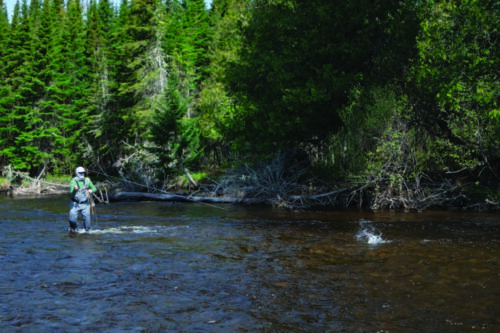
PUTTING PRESSURE ON THE FISH
After you’ve set the hook and the fish has made its initial run, your goals are to tire the fish and control it, so it doesn’t run too far away or have access to any obstacles – logs, sharp rocks, etc. – that might break the tippet. Keeping your rod tip high at the beginning of the fight helps get the slack off the water and prevents the fish from diving to the bottom, where it feels safe from predators. In general, your goal for the first few seconds is simply to hold on and maintain tension in the line between you and the fish.
Next, the fight begins in earnest, as the fish may run in any direction or try to get to anything that makes it feel safe. The best way to control and tire a fish is to apply side pressure whenever you can. Lay your rod over until it’s parallel to the water’s surface, and pull in the direction opposite of where the fish is trying to go. If the fish tries to run upstream, apply side-and-downstream pressure, for instance. When you pull against a fish, do so smoothly and always be ready for
the fish to react and take some line. When the fish gets close enough that you’re ready to net it, be very careful. Many trout are lost at this point, as the angler tries to control the rod tip, the fish and the net. Try to avoid bringing the fly- line-to-leader connection through the tip-top guide, because if the fish runs again, that connection can snag in the guide, causing the tippet to break.
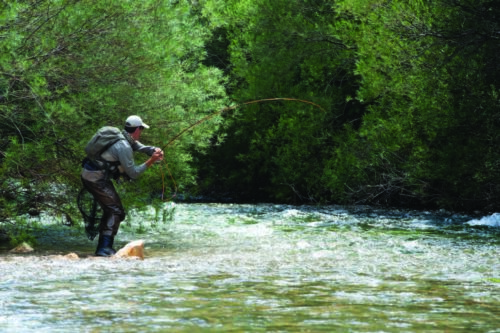
NETTING TROUT
Make sure that you carry your net in such a way that it’s easily accessible with one hand. When you feel that the trout has been tired out and you’ve got it close enough, grab your net. The problem is that you’ve got 9 or 10 feet of leader and line beyond your rod tip. Reach behind you with your rod hand, holding the rod tip high, and reach toward the fish with your net hand. Put the net halfway in the water, lead the fish into the net, and lift with a scooping motion. Ideally, you want to net the fish headfirst, but a thrashing, twisting trout doesn’t always cooperate. Be very careful not to touch your tippet with the net, as you could cause it to break. ASJ
Editor’s note: Order the book at amazon.com/Orvis-Quick-Start-Guide-Fly- Fishing-Everything/dp/1493036483. For more on the author, check out orvis.com/ uncategorized/phil-monahan.
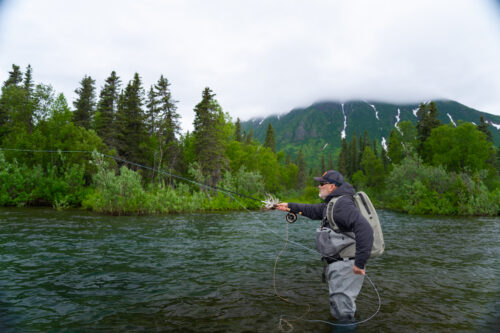
Sidebar: AUTHOR PHIL MONAHAN ON ALASKA ADVENTURES
Alaska Sporting Journal editor Chris Cocoles caught up with author Phil Monahan, who previously was a guide in Alaska.
Chris Cocoles Congratulations on the new book, Phil. Great read and so informative for beginning fly anglers. What inspired you to pursue this particular project?
Phil Monahan I’ve always been frustrated by the fact that people don’t try fly fishing because they believe it’s too complicated or too hard to learn. I don’t believe that it is, and I wanted to share some skills to help folks make that first big step and find success.
CC How did you get your start as a fisherman?
PM My paternal grandfather was an avid sportsman – hunting, fishing, trapping, you name it. He always took my brothers and me fishing on the ponds near his house when we visited. Reading his sporting magazine was my first glimpse into the wilder world of field sports.
CC From your bio it looks like you didn’t get into fly fishing until you were well into your post-graduate college years at the University of New Hampshire. What prompted that and how did you become such a fly fishing savant?
PM I had gone to college in New York City, which meant I had few opportunities to fish. My older brother, Brian, who lived near UNH, had taken up fly fishing and wanted to teach me. I think he needed a fishing buddy. I fell in love with fly fishing instantly and devoted all my free time to becoming better at it. I read voraciously and watched all the Saturday morning TV shows.
CC What was the moment that took you to Alaska to guide?
PM I did it the old-fashioned way. I mailed old-school cover letters and resumes to every lodge in Alaska, and one of them actually responded. The job turned out to be a disaster, but it got my foot in the door.
CC I ask this of a lot of people who’ve spent significant time there and experienced something crazy, but do you remember having a welcome-to-Alaska moment?
PM The guy who initially hired me was both bankrupt and insane, which is a bad combo. But he did own a beautiful lodge on the Deshka River. He dropped me off there aloneto get things ready for clients. I found myself in the Alaska bush without a gun, with a lodge full of non-working equipment, fending for myself for two weeks. I nearly set the forest on fire at one point while trying to burn the lawn.
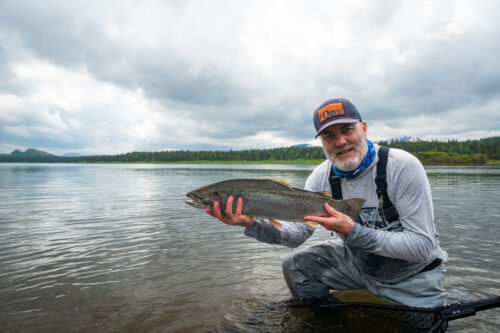
just a tiny portion of the state,”
Monahan says of his Last Frontier
adventures and future trips he’d like
to take there. “I’d love to fish in the
Southeast, in the Yukon, in Western
Alaska. Catching a sheefish on a fly
would be a dream.”
(PHIL MONAHAN)
CC Did you have a special guiding moment on an Alaska river that you can share?
PM [Emails midcurrent.com/stories-essays/patience-pays-off-in-alaska; the following is a sample from that piece]: As we watched the trout rising against the bank, Tom noted that there were a few small mayflies on the water – an olive-and-rust species neither of us had ever seen before – so we decided to start with a size 18 olive Comparadun.
After half a dozen drifts, we knew the fly was wrong because the fish didn’t even bother to inspect it. Over the next half hour, we ran through the rest of Tom’s small mayfly patterns – duns, emergers and unweighted nymphs – to no effect. Instead of getting annoyed or frustrated, however, Tom seemed to become only more interested and focused on the dilemma. It was clear that he had no intention of giving up on this fish, which continued to rise in its maddening rhythm.Tom’s attitude was contagious, and I rummaged through my vest for a box of patterns I’d used the summer before while guiding on the spring creeks of Paradise Valley, Montana. When he saw how small the flies were, Tom raised his eyebrows. “Never thought I’d be using those in Alaska.”We’d deduced that the fish was probably eating emergers, taking them right in the surface film. I tied on a size 22 olive CDC Emerger, and Tom laid down a perfect cast. For the first time, the trout showed real interest, but it still refused the fly. We knew we were on to something. [See the above link for the rest of Monahan’s story.]
CC It looks like you’ve spent a lot of your Last Frontier time in Bristol Bay? How special were those days?
PM I spent just one summer guiding at Rainbow River Lodge (rainbowriverlodge.com), on the Copper River. It was incredible, spending time surrounded by bears and casting for big rainbows hundreds of miles from civilization. I was lucky enough to be there when you could have a spot like the confluence of Moraine and Funnels Creeks all to yourself.
CC On the subject of Bristol Bay, some of your time at Orvis has been spent speaking out against and fighting the Pebble Mine. Why does that mean so much to you to keep that area protected?
PM When you spend enough time in the region, you learn how special – and how fragile – the ecosystem is. I knew that Pebble was an existential threat – not just because of the mine itself, but the extensive infrastructure that would be required to support it. Roads, pipelines, ports would all ruin the place that I had come to love.
CC Have you been back to Alaska in recent years, and do you still have places there you want to fish in again?
PM I spent a week at Tikchik Narrows Lodge (tikchiklodge.com) last summer. I had never been to the “west side” of Bristol Bay, and I loved it. When you’re a guide, you really see just a tiny portion of the state. I’d love to fish in the Southeast, in the Yukon, in Western Alaska. Catching a sheefish on a fly would be a dream.
CC I know salmon are the top priority for a lot of Alaska anglers, but tell me about fishing for trout there. PM I was very lucky that Rainbow River Lodge was focused on trout rather than salmon. I find trout more fascinating and challenging than salmon, especially during that window before the salmon arrive, when the trout are eating insects and smolts. The Copper River was remarkable for Alaska in that it had big hatches of stoneflies, caddisflies and mayflies that brought trout to the surface.
CC You’re a well-known and respected outdoors editor and you’ve also represented Orvis for a long time. What’s it been like to be associated with such a prestigious brand?
PM There were pros and cons. As editor of American Angler, I engaged with the entire fly fishing world. Once I went to Orvis, I was sequestered within a single company. That said, Orvis was a great company with great values, and they believed in the power of sharing information. You’ll note that no other company has a blog site like Orvis News. And they gave me free reign to represent the brand. Plus, I worked with incredible people, from Tom Rosenbauer [the longtime fishing writer who wrote the foreword in Monahan’s book] to the guys in product development.
CC You’ve guided in two of the nation’s most storied fishing states, Alaska and Montana, but how much have you enjoyed your fly fishing experiences in your home New England states?
PM New England will always feel like home for me, and I’m happiest working up a mountain freestone stream, casting for wild brook trout. Casting a dry fly while wet-wading on a mountain brook trout stream is heaven for me. I can get lost in the rhythm of working from pool to pool, covering the water, and trying to make accurate casts and good drifts. I sometimes completely lose track of time, though, which can get me in trouble.And that moment when a trout smashes the bug is always a thrill, even if it’s the 20th time that day. Finally, holding a brightly colored brookie – with its brilliant reds and blues – completes the experience. CC



